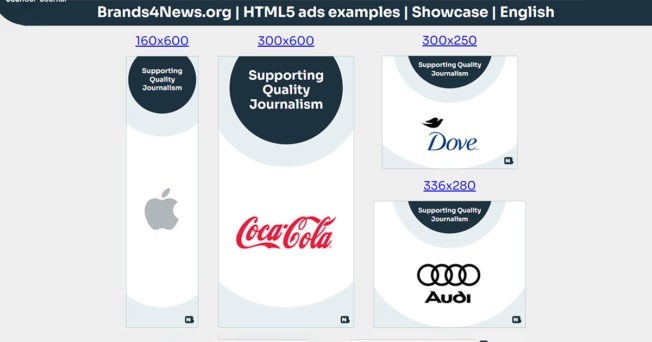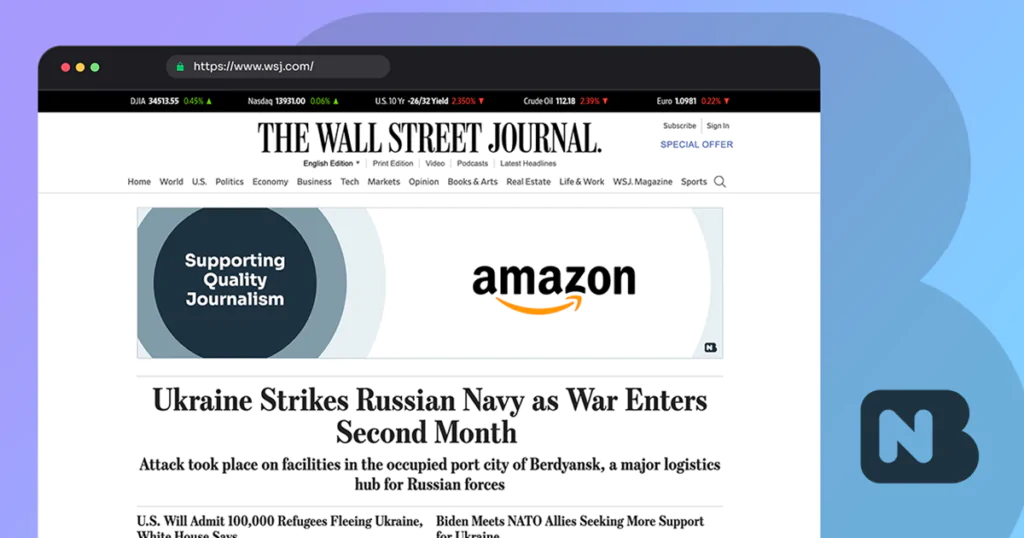Posted on 23 June 2022 in News-sub
Brands4News.org is creating banner ads to incentivize brands to fund wartime reporting

As war broke out in Ukraine, readers flocked to Ukrainska Pravda, one of the country’s largest outlets, to learn about the biggest European conflict in decades.
During the first 30 days of the conflict, Pravda generated more than 900 million page views, a record for the site, according to the CEO Andrey Boborykin. Before the war, Pravda averaged 100 million monthly page views.
When a business provides a valuable service, typically its bottom line improves. Instead, Pravda’s programmatic revenue during the first month of conflict cratered by 90%, while native ads went to nearly zero, Boborykin said.
While part of this downturn can be attributed to a pullback from cash-strapped Ukrainian businesses, also to blame are international brands with full coffers, who avoid advertising on wartime coverage to prevent negative consumer sentiment, he said.
“We avoided layoffs … because we are big enough to earn enough money from programmatic and get donor support,” Boborykin said. “Most of the news organizations [in Ukraine] are seeing significant cuts.”
Brands4News.org, a new industry initiative officially launching today, is working to mitigate this problem of brands pulling ad spend, which has repeated itself in crisis after crisis, from the Covid-19 pandemic to the Black Lives Matter protests. Brands fear looking tone-deaf by showing their ads next to grisly content; for example, Applebee’s became the butt of jokes when its light-hearted ad appeared next to Ukrainian war footage. But in the process, critical crisis journalism loses its funding.

Another example of how a brand who uses the banner might appear on a publisher’s website. Brands4News.org
Brands4News.org’s solution is to offer brands free-to-use creative templates that they can imbed into their existing display advertising. The templates, whose source code brands can put directly into ad servers, indicating that the advertiser is “supporting quality journalism.” The hope is that the banners help brands retain positive consumer sentiment, highlighting that the choice to advertise next to quality journalism is indicative of civic responsibility, not insensitivity.
“It is a paradox,” said Ruben Schreurs, who founded the initiative and separately serves as group chief product officer at ad-tech company Ebiquity PLC. “[Publications covering crises] have more readers, more global reach so the opportunity is bigger but their net income is massively down. There is an opportunity for pioneering brands that can buy that reach in a really effective manner.”
The publisher’s paradox
Schreurs founded and is self-funding Brands4News.org, in part as a response to the flagging advertising revenues of publications covering the war in Ukraine. The initiative is supported by a team of 14 contributors from companies like Magnite, Kepler Group, Jounce Media and the Global Disinformation Index.
Five contributors are Ukranian nationals, including Dmitry Gnatiuk, who created the initiatives’ banner templates from a shelter in Kyiv.
The initiative’s contributors are all working to evangelize the project with their array of contacts in the industry, Schreurs said. While Brands4News.org started today, it has already been in touch with industry bodies like the World Federation of Advertisers.
Despite the CNN brouhaha, brands’ fears about negative associations—and the use of blunt keyword ad-blocking technologies—can be misguided, Schreurs added. Research from Disney and Magna published last year found that audiences viewed brands more favorably for advertising against news, especially trusted media sources, even if the content of that news was “heavy.”
When brands avoid news during times of crisis, “they end up advertising on lower-quality content, the entertainment pages or on fluff publications,” Schreurs said.
Brands4News.org is also providing advertisers with inclusion lists of reputable Ukrainian and mainstream English language publications, the latter of which have been vetted by the Global Disinformation Index. There are other inclusion lists out there for advertisers, notably one from another industry coalition called Ads for News.
With Ukraine still in the throws of conflict, Boborykin said Ukrainian companies often do not have the means to purchase ads, meaning international companies and donations are Pravda’s lifeline. The publication is still averaging more than three times its pre-war readership. Now, 30% of its audience is international, with many Ukrainians having found refuge overseas, in countries like Poland and the Czech Republic, where Pravda can reap higher CPMs than in Ukraine.
Case in point: the English-language version of Pravda, which is mostly read in the U.S,. accounts for 10% of the publication’s audience but 30% of its programmatic revenue. That means international aid is crucial, Boborykin added.
